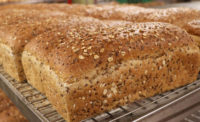Foodservice channels bring in nicely diversified revenue for bakers and snack manufacturers, covering product categories that include snacks, appetizers, pizza crusts and breads for sandwiches. Some of the hottest concepts in foodservice today include pizza in quick-service restaurants (QSR) and fast-casual restaurants, bakery cafes, and sandwich activity across multiple segments. When these foods are made with ideals like better-for-you and artisan in mind, they can create strong, lasting connections with key consumer demographics.
The ‘snackification’ of America
Foodservice has a great level of opportunity to capitalize on consumer desires for snacking throughout the day. “The greatest strength that snacking offers is that it is not bound by the clock,” says Suzy Badaracco, president, Culinary Tides, Portland, OR. “Compared to appetizers, for instance, snacks are timeless, whereas appetizers are relegated to the time before a meal. Snacks can be eaten before a meal, as a meal itself, or later after a meal. Snacks can also be sweet or savory, whereas appetizers are primarily savory.
“The positioning that can be taken advantage of is really in semantics,” continues Badaracco. “By calling a small dish a snack instead of appetizer, for instance, it can be introduced to establishments that don’t offer appetizers, but now can play in smaller plates. It can also allow the small offerings to be spread throughout the day, instead of locking them into a before-a-meal positioning. It allows them freedom. Snacks also tie into the portion-option trend, where consumers want the choice between a regular-sized and small-sized portion of a dish.”
Badaracco also points to “clockless eating” as an opportunity. “Clockless eating is helping to fuel the all-day breakfast, late-night snacking and small-plate trends,” she says. “Clockless eating manifests itself in various ways. Younger generations are among the ‘no rules’ clockless crowd, where meals and snacks are not tied to any particular foods or times.”
Pizza tactics
Select operators continue to see strong growth in pizza across different segments. In fast-casual, Pieology Pizzeria saw the most growth in the segment, with a sales increase of 230.4 percent from 2013 to 2014, to $44.6 million, per Technomic, Chicago. During that period, total units in the chain grew from 15 to 42. Speedy and artisan form the backbone of the Pieology strategy. The chain bills its pizzas as artisan creations. Custom-ordered pizzas are baked in stone ovens, ready in five minutes or less.
Marco’s Pizza, a more-traditional delivery concept that focuses on “authentic Italian” pizzas, is also seeing strong growth, up 31.3 percent from 2013 to 2014, to $310.9 million in sales, with total units increasing from 433 to 570, per Technomic.
Bob Grote, CEO, Grote Co., Columbus, OH, notes that gluten-free is an area of growth for the pizza industry. “It is now more common than not for a restaurant to offer a gluten-free crust,” he says. “Also, the ‘speedy’ pizza has become more available with the proliferation of the turbo-type ovens.”
Grote points toward “artisan” as a top area of potential growth, with top national and regional chains getting into the artisan game. People expect “fresh” toppings, and while the staples, such as pepperoni, bacon, etc., will continue to rule, “nontraditional sauces and high-end toppings, such as prosciutto, mushrooms mixes and exotic cheese blends, will become common offerings.”
One approach to bringing more efficiency to pizza chain concepts focuses on a quick order turnaround time through pre-topping pizzas at the factory. Grote suggests that some operators consider the highly efficient approach of using automated lines to apply sauce and cheese to crusts at the plant. “Even popular toppings, such as pepperoni, can be applied at the factory as well,” he says. “Pizzas are then ‘finished’ with the toppings requested by the customer. Consistency, quality and portions can be tightly controlled in the production environment, while greatly speeding up the restaurant’s preparation time.”
The sandwich scene
“The restaurant industry has always been an environment of tradition and evolving flavors,” says Chris Martone, executive chef, Subway, Milford, CT. “Today’s world is more progressive than ever. Methods of cooking and preservation that were once for survival are now considered hip and cutting-edge. The trends of artisan breads, pickling and preserving, and cheese pairings can make some memorable sandwiches.”
The most-popular bread at Subway is the Italian Herb and Cheese bread, featuring Italian seasonings topped with Monterey Cheddar cheese, notes Mark Christiano, global baking specialist, Subway. “As testament to our menu innovation designed to meet customers’ evolving tastes, we recently introduced some exciting new local market options featuring Southwest Spicy and our Sweet Hawaiian Breads.”
Subway also hasn’t shied away from fortifying breads with nutritional ingredients. “Over the years, we have made many quality improvements that feature recipe changes and added healthful ingredients, such as fortifying with whole grains, fiber, vitamin D and calcium,” says Christiano. Also, the FreshFit line at Subway offers a variety of 6-inch sandwiches that are low in fat, saturated fat and cholesterol.
“Consumers are more aware of good carbs and ‘bad’ carbs, but, thankfully, there is still room in our lives for both,” says Ric Scicchitano, executive vice president, food & supply chain, Corner Bakery Cafe, Dallas. “As an example, Corner Bakery Cafe introduced a Multigrain Power Flat Bread breakfast sandwich that has been very well received and delivered on a healthful breakfast choice.”
Scicchitano notes that the Chicken Pomodori Panini is the best-selling sandwich at Corner Bakery Cafe. “We use very high-quality ingredients, from our signature sourdough bread, all-natural chicken, homemade pesto and oven-roasted tomatoes bursting with flavor,” he says. The sandwich is grilled between two iron plates to toast the bread.
Great sandwiches start with great bread. “Great bread for dinner can have a good crust, while breads for sandwiches need to deliver a taste that doesn’t fight with you while eating the sandwich,” says Scicchitano. “Above all, they must complement the flavors of the ingredients. Lean sourdough breads work perfectly for panini, while some richer or sweeter artisan bread with a softer bite will eat better cold or lightly toasted. Regardless, artisan bread needs to pass the eye test first, be it a heathy-looking crust and shine showing proper mixing and fermenting techniques were followed. A dusting of semolina or durum or even very fine corn meal on the bottom is possible, or even better yet, the right amount of grains or seeds in or on top of the loaf. Artisan breads have broad possibilities on shape, size and height to allow each sandwich to have its own identity and unique look.”
Snackable sides
Chips are a quintessential side to sandwiches, and we’re starting to see more diversity in this market. One new chip product from ConAgra Foods, Lamb Weston’s House Cuts Lattice Chips, builds clean-label dynamics and sourcing transparency into the concept. They’re made with only three ingredients—potatoes, oil and sea salt—and operators can also source the growing region of their potatoes with www.TraceMyFries.com. The chips are designed with holes to give them an even, golden color and a crisp, airy bite. They have the skin on.
Chip manufacturers have access to equipment that can deliver products in a wide range of styles. The Urschel Model CCL can produce lattice cuts with varying levels of thickness, with crinkles on both sides of the chip. Cut types include fine, coarse and deep lattice. The equipment also accommodates thicker configurations to create waffle fries.
Badaracco also suggests that chip producers could also gain more traction in foodservice by diversifying into a wider range of grains. “Chips are coming in well beyond the usual potato and corn varieties,” she says. “The next generation involves expanding the boundaries into beans, hummus, sweet potato, quinoa, kale, carrot, black sesame, and on and on.”













